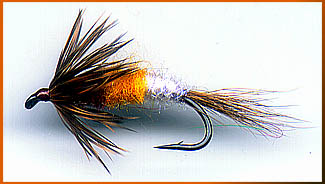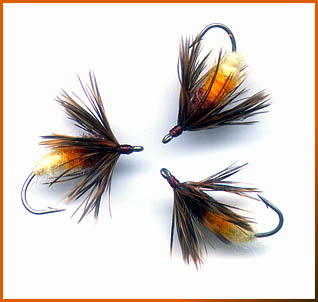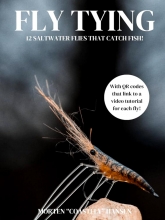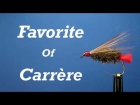The Bumble Bee
This pattern was originally made one evening when I was tying with some friends. My friend Henning had some light SLF left over from one of his flies. I scavenged the SLF and started a fly on a heavy Tiemco hook. The tail was casually made from some natural bucktail that I had brought.
 The Bumble Bee on a heavy hook
The Bumble Bee on a heavy hookThis pattern was originally made one evening when I was tying with the Bananaflies. My friend Henning had some light SLF left over from one of his flies. I scavenged the SLF and started a fly on a heavy Tiemco hook. The tail was casually made from some natural bucktail that I had brought.
As the white SLF only reached a third of the hook shank. So I changed to some yellow Scintilla and the last third was covered with dark brown Scintilla.
The fly was finished with a soft brown grizzly hen hackle.

A smaller version with no tail
During some unproductive winter fishing for sea trout with the heavy fly I found it a bit on the rough side in the clear water. It did fine, but I wanted something a bit more discrete, but with the same attractice colors.
From this came the Bumble Bees shown here. These were tied on much smaller hooks. First with tails and later without. This version produced a couple of very small fish on a very calm winters day. I actually managed to spook a few fish on that day - a thing that only rarely happens with sea trout in the sea.
I like these soft hackle types of flies, and the Bumble Bee hasn't seen its last trout - hopefully.
![]()
| Hook Small version |
Tiemco TMC 700 size 2-4. Partridge GRS12ST Nymph/emerger size 6 |
| Thread | Brown |
| Tail (optional) | Bucktail |
| Body | Dubbing; one third light/white, one third yellow, one third dark brown |
| Hackle | Soft, brown, grizzly hen hackle |
| Head | Thread |
![]()
- Start the thread at the hook bend.
- Tie in a sparse tail of unstacked bucktail. It should be approx. same length as the shank.
- Dub a little less than one third of the body with light dubbing
- Follow by orange and brown dubbing. The body should be slightly tapered.
- Prepare a soft hen hackle
- Tie in tip first in classical wet fly style
- Wind the hackle 3-4 times
- Tie down and cut surplus
- Form a nice head from the tying thread
- Varnish
Read more about why you should register.
More content from the front page
Since you got this far …
… I have a small favor to ask.
Long story short
Support the Global FlyFisher through several different channels, including PayPal.
Long story longer
The Global FlyFisher has been online since the mid-90's and has been free to access for everybody since day one – and will stay free for as long as I run it.
But that doesn't mean that it's free to run.
It costs money to drive a large site like this.
See more details about what you can do to help in this blog post.

























































